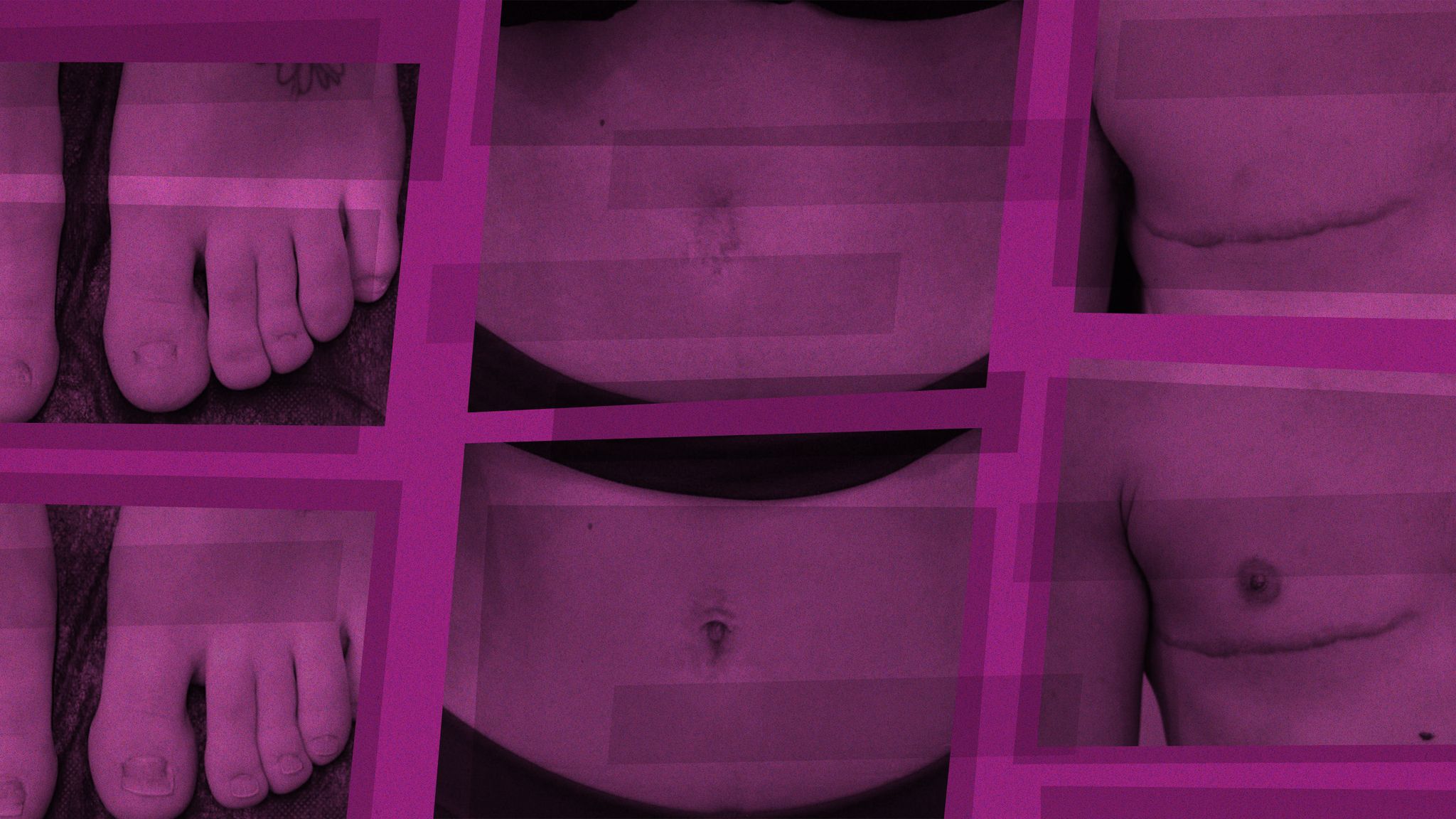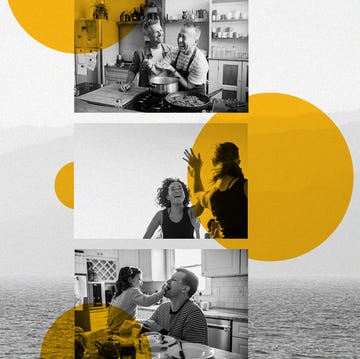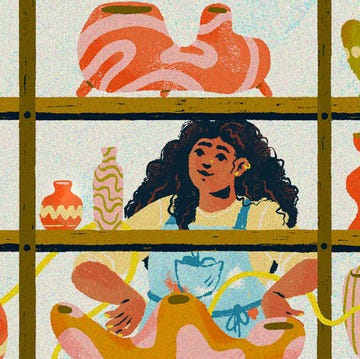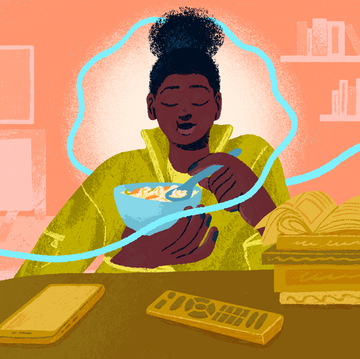Sara Johnston waited a year for her body to look normal again. After being diagnosed with breast cancer last summer at age 39, she underwent chemotherapy, radiation, and a double mastectomy. Surgeons then inserted tissue expanders beneath her skin to prepare for breast reconstruction, which took place in the spring. Johnston’s journey finally concluded last month when she had realistic-looking areolas tattooed onto her reconstructed, nipple-less breasts.
“It does feel like completion, as far as my reconstruction process,” Johnston says. “Seeing the end product in the mirror definitely made me emotional. To have something there that’s a reminder of what you had — it’s not normal, but it’s a piece of normalcy.”
Known also as paramedical tattoos, reconstructive tattoos can re-create areolas, restore belly buttons or lost fingernails, and camouflage scarring. Using artistic techniques in the style of trompe l’oeil, tattoo artists create the illusion of depth and dimension so the areola looks like it protrudes, the belly button seems concave, and the fingernails appear real.
Reconstructive tattoos are crafted with the same machinery and general process as decorative ink, but they are far more emotional to create and receive, according to artist Shaughnessy Otsuji, who specializes in reconstructive tattoos. “The goal is always to make it look like an undetectable tattoo, essentially just replicating a natural feature that they would have,” says Otsuji, co-owner of Studio Sashiko tattoo shops in Los Angeles and Vancouver, Canada.
Where decorative tattoos are often marked by vivid colors and bold lines, restorative tattoos are considerably more understated. The goal is to blend in rather than stand out. “The main difference, specifically with the belly buttons and the nipples, is that it’s more natural [with] soft colors,” says Otsuji, who takes color cues from a client’s skin undertones, freckles, and lip color, then blends a unique custom shade. “I’m generally diluting a bit of the ink, making it a little more like a watercolor tattoo.”
Who receives reconstructive tattoos?
Breast cancer survivors aren’t the only candidates for restorative tattoos. Transgender and nonbinary people who’ve undergone chest-masculinizing top surgery often seek out realistic areola tattoos to complete their new look. Women who’ve had a breast reduction or lift may also need the procedure, according to Marie Sena, owner of Restorative Tattooing in Dallas.
“Any time they have to move that areola around — like detach it and reattach it — sometimes that nipple will necrose, so they’re left without a nipple,” Sena says. “It’s not just breast cancer or top surgery, but it can be something as simple as getting a breast reduction. That’s just another application of restorative tattooing that doesn’t even apply to cancer but is still fraught with emotional importance.”
Restoring a belly button with tattoo ink can also be surprisingly emotional, Otsuji says. The first tattoo belly button she created was for a client who had hernia surgery and was left with a massive amount of scar tissue where her navel was formerly located. Tummy-tuck surgeries, umbilical hernia, and abdominal revision after rapid weight loss are among the conditions that could leave a person without a belly button.
Drawing on similar techniques used to create the illusion of protrusion with areola tattoos, Otsuji made a 3D-looking belly button by playing with light and shadow. “The beautiful part of it is the confidence you see afterward,” Otsuji says. “When I was finished with one of my clients in Los Angeles, she was like, ‘I’m going to buy so many crop tops.’ I was really excited for her [because] a belly button is not something we generally think about throughout the day, but if you don’t have one, it’s definitely a concern.”
Missing fingernails can also be reconstructed with tattoos. Otsuji recently created a full set of toenails for a client. “I’ve already had quite a few requests for that,” she says, adding that dancers and athletes can lose toenails through trauma to the toes.
Eric Catalano, owner of Eternal Ink Tattoo Studio in Hecker, Illinois, saw his work go viral after tattooing a pair of fingernails on a client who’d lost the tips of two fingers in a work accident. The client requested the tattoos almost as a joke, but they had a resonance far beyond what he could have imagined.
Who creates reconstructive tattoos?
While some plastic surgeons and nurses offer reconstructive tattoos, medical professionals increasingly refer patients to professional tattoo artists who specialize in these techniques. Otsuji and Sena each started their careers as traditional tattoo artists before developing an interest and expertise in restorative work.
Sena had a dual career as a tattoo artist and medical illustrator who made detailed anatomical drawings for textbooks. A physician whose textbook she was illustrating suggested Sena combine her skill sets and connected her with a plastic surgeon who did breast reconstruction.
“It felt wonderful to be tattooing but also to be doing something that was service-oriented,” Sena says. “The feeling that I got was very different [from] normal tattooing. It was a very emotional, fulfilling feeling, so I’ve been doing it ever since.”
For the vast majority of her clients, having an areola tattoo is their first — and only — tattoo experience. “To them, this is very foreign,” Sena says. “I do the thing that makes the clients the most nervous.” That’s because, she explains, from a breast cancer diagnosis to treatment and healing, everything is prescribed and experienced by a patient according to medical protocol. A restorative tattoo is entirely optional and up to an individual to pursue.
Otsuji, who studied portraiture in art school, was tattooing eyebrows and creating decorative tattoos before focusing exclusively on restorative designs. “I was doing the brows of a lot of women who had gone through chemo due to breast cancer,” she recalls, “so nipples were a topic that kept coming up.” Now, Otsuji regularly receives referrals from surgeons. Instagram has also helped her spread the word about her unique work and what’s possible in the realm of reconstructive tattoos.
Like Sena, Otsuji finds that many of her restorative-tattoo clients are new to the tattoo world, so she designed her shop to be a gentle, inviting space — a spa-like place where clients can come home to their own bodies again. There’s no loud music playing or flashy art covering the walls.
“The most rewarding part of what I do is watching clients in the mirror,” Otsuji says. “It’s a lot of tears [and] hugs. I’m honored to be a part of that because it’s the happy part of their whole transition, cancer journey, whatever they’ve been through. It’s like the fun part at the end.”
For breast cancer survivor Johnston, her appearance changed so much throughout her journey that she didn’t recognize her body. First, she lost her hair, eyelashes, and eyebrows from chemotherapy. Then, she lost her breasts. “It was really hard, for the longest time, to actually even look at myself,” she says.
Active with breast cancer support groups online, Johnston started following Otsuji’s work during treatment. Visiting the artist’s Vancouver studio and having her create areola tattoos felt like crossing a finish line, restoring her sense of comfort with her body and inspiring her to be a little playful in the process. “I went for heart-shaped areolas because,” she says, “why not?”
Sandy Cohen is a Southern California-based health and wellness coach, host of the Inner Peace to Go podcast, and writer of the Shondaland series A Path to Well-Being. Follow her on Twitter @YouKnowSandy.
Get Shondaland directly in your inbox: SUBSCRIBE TODAY













